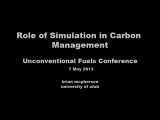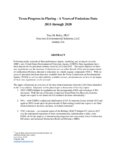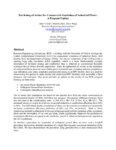TO
Filters: Collection: "ir_eua" Type: "Text"
| Title | Date | Subject | Description | ||
|---|---|---|---|---|---|
| 1 |
 |
Data informed multipoint ground flare evaluation using measurement and theory | This paper will explore the comparison of experimental (PFTIR) and simulation data obtained from assisted multipoint ground flares operating at high turndown. The flare assist is intended to encourage air entrainment for best combustion efficiency as well as reduce visible smoke. Operational envelop... | ||
| 2 |
 |
Proposal for the development, calibration, and application of an empiric activity allocation model for the Wasatch Front urban area of Utah | 1968-07 | The comprehensive land development and transportation planning process for a growing region like the Wasatch Front should tie together all the interrelated planning activities -- establishing land development and transportation policies, forecasting land development and activities, forecasting trave... | |
| 3 |
 |
Statistical Abstract of Utah 1973 | 1973-02 | The Bureau of Economic and Business Research presents the sixth edition of the Statistical Abstract of Utah, 1973. The basic goal of this document is to bring together under one cover the data most often requested in a readily available format. During an average year, government agencies, business f... | |
| 4 |
 |
Description of work elements | 1968-08-26 | Previous programs have initiated and refined the development of a Utah population model to be used in projection of future requirements of both public and private facilities, goods and services. | |
| 5 |
 |
Kinetics of Colorado oil shale pyrolysis in a fluidized-bed reactor | 1985-05 | kinetics of Colorado oil shale pyrolysis; fluidized-bed reactor; oil shale pyrolysis; oil shale; hydrocarbon evolution | The hydrocarbon evolution data of Richardson et al. (1982) is reanalyzed to determine improved rate expressions for oil generation from Colorado oil shale under rapid pyrolysis conditions. Contributions from low molecular weight gases are subtracted from flame ionization detector data to obtain the ... |
| 6 |
 |
UUSAC AdPAC 1993-1994 | 1994 | Minutes | Agendas and minutes for meetings of the Administrative Policies Advisory Committee |
| 7 |
 |
Description of work elements IV: land use model | 1968-08-26 | Previous programs have initiated and refined the development of a Utah population model to be used in projection of future requirements of both public and private facilities, goods and services. The present state population forecasts are based upon the "cohort-survival" method of analysis of birth r... | |
| 8 |
 |
Lawrence Livermore National Laboratory oil shale (May 1989) | 1989-05 | isothermal pyrolisis kinetics; dust; oil shale; oil generation; micropyrolysis | I. Isothermal Pyrolysis Kinetics. II. Dust. |
| 9 |
 |
Northwest Asphalt Ridge tar sand deposit well logging and coring comparison | 1983-03 | Well logging techniques; Vernal, Utah; Rimrock Sandstone Member; Quantitative well logging techniques; Logging | Quantitative well logging techniques were performed on four wells used to conduct a small scale tar sand steamflood and four additional wells used to provide reservoir data for the design of a fourth field experiment near Vernal, Utah. The purposes of this study were to: summarize and present the lo... |
| 10 |
 |
Role of simulation in carbon management | 2013-05-07 | ICSE; Unconventional fuels; Carbon; CCS; Simulation | Presentation given at the University of Utah Unconventional Fuels Conference, Salt Lake City, Utah, May 7, 2013. |
| 11 |
 |
Economic evaluation of oil shale and tar sands resources located in the state of Utah: Phase 2 | 1982-10 | Technically accurate economic evaluation of Utah resources is essential to the future health of Utah's economy and for the sound management of Utah's lands and mineral/hydrocarbon resources. This report presents the results of the second year of research aimed at resources in the State of Utah. The ... | |
| 12 |
 |
1976 Statistical Abstract of Utah | 1976-01 | The Bureau of Economic and Business Research presents the seventh edition of the Statistical Abstract of Utah, 1976, the Bicentennial Edition. The basic goal of this document is to bring together under one cover the data most often requested in a readily available format. During an average year, g... | |
| 13 |
 |
Quality growth efficiency tools: progress report | 1997-04 | The Quality Growth Efficiency Tools project team has been meeting since July 1996 to develop a process and set of tools to improve the quality of growth related information to plan for Utah's future. The Project's stated purpose is to improve the technical and analytical models used to forecast gr... | |
| 14 |
 |
APPENDIX G - Detailed study of shale pyrolysis for oil production - A subpart of project oil shale pyrolysis and in situ modeling - Final Project Report - Reporting period: June 21, 2006 to October 21, 2009 | 2009-04-21 | Oil production; Shale assessment | The oil shale industry is going through a revolution of sorts. After the oil crisis in the 1970s, a great deal of effort was spent on research and development and on pilot scale technologies. Extensive research was conducted with on-surface and in-situ production methods. Even though some large pilo... |
| 15 |
 |
Simplified analysis and practical mitigation techniques for induestrial boiler thermoacoustic vibration | 2019 | Industrial boiler systems are prone to mechanical vibration which can lead to premature component failures, emission non-compliance, and greatly increased ambient noise generation. Driving mechanisms, thermoacoustic phenomena, and system geometrical interactions are complex. General methods for accu... | |
| 16 |
 |
Utah Statistical Abstract 1983 | 1983 | The Bureau of Economic and Business Research presents the ninth edition of the Statistical Abstract of Utah, 1983. The basic goal of this document is to bring together the data most often requested in a readily available format. During an average year, hundreds of calls and personal visits are made... | |
| 17 |
 |
Economic evaluation of oil shale and tar sands resources located in the state of Utah: Phase 1 | 1981-02-15 | Managing public lands for maximum social benefit is becoming an increasingly complex task. The growing need for domestically produced mineral raw materials and energy, and the conflicting interests over the use of public lands, have added new dimensions to the management issues. This report covers t... | |
| 18 |
 |
In situ oil shale/sands thermal treatment hierarchy | 2009-11-04 | hierarchial chart; in situ oil shale/sands; thermal treatment research; liquid fuel production; in situ thermal treatment technologies | Hierarchical chart for the in situ oil shale/sands thermal treatment research area showing connectivity between subtasks. This chart helps illustrate the integration and focus among the subtasks needed to achieve liquid fuel production demonstrations of in situ thermal treatment technologies and als... |
| 19 |
 |
P.R. Spring and Hill Creek Tar Sand Areas: A resource assessment (in progress) | 2008-02-22 | P. R. Spring; Hill Creek Tar Sand Areas; Uinta Basin; Green River; resource assessment | The P.R. Spring-Hill Creek Tar Sand Area is located at the southern flank of the Uinta Basin. The area is generally bounded by T. 12 S. in Uintah County, extending southward to T. 17 S. and the Roan Cliffs in Grand County. It is further bounded by the Green River on the west and the Utah-Colorado st... |
| 20 |
 |
Texas progress in flaring - 6 years of emissions data 2015 through 2020 | 2020 | Following nearly a decade of flare performance inquiry, modeling, and testing in the early 2000s, new United States Environmental Protection Agency (USEPA) flare regulations have been enacted for the petroleum refinery sector in 2012 and 2015. The stated objective of these new regulations was th... | |
| 21 |
 |
Attachment 2 - Statement of program objectives: Clean and secure energy from domestic oil shale and oil sands resources | 2009-09-24 | ICSE; University of Utah; Energy; Oil shale; Oil sands; CO2 capture; Liquid fuel; In-situ thermal processing; NOx emissions; CO2 emissions; Flameless oxy-gas process heaters; Efficient CO2 capture; Large Eddy Simulation; LES | The University of Utah (the Recipient), via their Institute for Clean and Secure Energy (the Institute), shall pursue research to improve industry's ability to utilize the vast energy stored in domestic oil shale and oil sands resources in a manner that shall minimize environmental impact and effect... |
| 22 |
 |
Clean and secure energy from domestic oil shale and oil sands resources: Quarterly progress report: April 2010 to June 2010 | 2010-07-31 | ICSE; Oil shale; Oil sands; Oxy-fuel; CO2 capture; OXYFLAM; Uinta Basin; Utah; Parachute Creek Member; X-ray microtomography; Freen River oil; Kerogen; Thermal gravimetric analyzer experiments | The Clean and Secure Energy from Domestic Oil Shale and Oil Sands Resources program is part of the research agenda of the Institute for Clean and Secure Energy (ICSE) at the University of Utah. In this quarter, the Clean and Secure Energy program continued its efforts to enhance the dialogue between... |
| 23 |
 |
Oil shale heat-capacity relations and heats of pyrolysis and dehydration | 1987-05-06 | Green River shale; Enthalpy changes; Kerogen pyrolysis; Bound-water dehydration; Devonian shales | New relations are developed for calculating enthalpy changes during heating, retorting, or cooling of raw, spent, or burned oil shales of various compositions. The relations describe the sensible heats of the minerals, kerogen, and char, and the reaction heats of kerogen pyrolysis and bound-water de... |
| 24 |
 |
Application of a self-adaptive detector system on a triple quadrupole ms/ms to high explosives and sulfur-containing pyrolysis gases from oil shale | 1983-12 | A totally computerized triple quadrupole MS/MS is being extended into a dynamic, self-adaptive chemical analysis system at Lawrence Livermore National Laboratory. These first efforts toward Artificial Intelligence guided instrumentation (i.e. Expert Systems) involve the implementation of a self-adap... | |
| 25 |
 |
Hardening of arches for commercial simulation of industrial flares: a program update | Reaction Engineering International (REI) is working with the University of Utah to leverage the Uintah Computational Framework (UCF) for commercial simulation of industrial flares, with funding from the Department of Energy (DOE). The Arches component of the UCF provides a reacting large eddy simula... |
